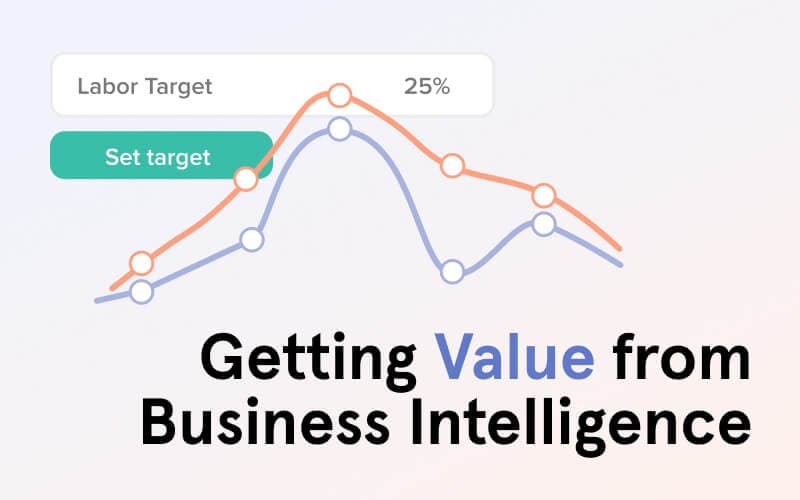Making decisions for your restaurant without business intelligence is like trying to run a sushi restaurant without fish — without it, you aren’t going to stay open for very long. It’s what separates the restaurants that survive from the restaurants that thrive.
Restaurant business intelligence, or BI, “leverages software and services to transform data into actionable insights that inform an organization’s strategic and tactical business decisions.” While business intelligence can be used by any restaurant, it’s largely relied upon by multi-unit brands due to the impact of its findings across locations, as well as the group as a whole.
Why is restaurant business intelligence important for multi-unit brands?
Consider a restaurant that uncovers a way to cut labor costs by 5%. For a single restaurant with $300,000 in labor costs for the year, that’s a respectable $15,000 saved. For a 20-unit brand with $6,000,000 in annual labor costs, that number jumps to $300,000 saved.
Business intelligence requires investments into powerful software and tools, but rewards restaurants with clear and actionable ways to improve their bottom line.
Getting value from restaurant business intelligence
Gathering the data can be easy—but the true value in business intelligence for restaurants comes from the decisions it informs. BI points out the big swings restaurants can make to improve their operations and profitability. Specifically, BI helps leaders understand what trailing locations are doing wrong, so it can be stopped. Additionally, it helps to know what more efficient locations are doing right, so these best practices can be taught and systemized for growth.
From staff engagement to Business intelligence can provide real value for multi-unit restaurants in a variety of ways.
Compare actual and projected sales & labor data
Restaurant business intelligence summarizes how accurate the restaurant is when it comes to sales and labor forecasting. Getting these numbers right means less expired inventory, fewer unhappy customers, shorter wait times, and lower labor costs. Tools like the Operations Overview feature in 7shifts even allows you to drill down to see the discrepancy between projections and actuals for both sales and labor data for every location.

Access to these numbers can ensure your managers make smarter decisions when it comes to ordering inventory and scheduling staff. For example, if you constantly find yourself coming up short on sales projections, you can limit inventory orders and employees per shift for that location.
In the long term, you can consult with the heads of these trailing locations alongside those who manage thriving ones to uncover what sets them apart. If you find that one location has longer wait times than other locations, which causes guests to go elsewhere. The manager of the underperforming restaurant can reinvest in training to ensure guests don’t have to wait as long and the kitchen is more efficient.
These metrics also help restaurants compare their earned and actual labor hours. Here, business intelligence tools can help your managers understand exactly how many hours they should be scheduling staff for throughout the week for maximum efficiency and profitability, and make cuts or bring in on-call workers as needed.
Recommended Reading: Restaurant Forecasting: How To, Formulas, Methods, and More
Optimize staff schedules
One of the best aspects of business intelligence is that it does a lot of the work for you. Not just when it comes to gathering data, but also in the decision-making process. In restaurant business intelligence, this is especially true for scheduling.
For example, employee auto-scheduling software gathers information on staff availability and forecasted restaurant demand to build an ideal schedule, factoring in costs, overtime, compliance laws, and even the weather. Information from multiple data sources are centralized to help restaurants slim down costs in one of their largest areas of expenditure.
Main Squeeze, a multi-unit juice bar, found they were able to use business intelligence tools to monitor and control labor costs with absolute ease. “We shoot for a 50% cost of labor for an owner-operated store. And then a 22% cost of labor number for a location that has a manager,” says Main Squeeze’s Director of IT Jessie Williams. “What we found is that, with 7shifts, we’ve been able to consistently hit those numbers just because of the tools that are available.”
Now, some locations will have more accurate schedules than others — even with access to this information. In the end, the decisions need to be made by well-informed leaders on your team. Illustrative data reports and dashboards that highlight everything from attendance, to breaks, to total labor costs give your restaurant group every data point it needs to keep labor costs manageable across locations. And with labor costs accounting for around one-third of a restaurant’s revenue, any opportunity for optimization must be taken.
Recommended Reading: How To Manage Teams Across Multiple Restaurant Locations
Identify your least most profitable items (and stores)
The bottom line? Business intelligence is the key to a higher profit margin for your restaurant group.
Next to labor, food cost is a restaurant’s largest expense. Your restaurant likely does regular menu engineering and analysis to keep your offerings unique, but how often do you do this by location?

Business intelligence helps pinpoint your moneymakers and profit killers for each store. When menu engineering, you’ll get an easily digestible visualization of which menu items are most beneficial to your restaurant, which ones need their prices raised/costs dropped, and which ones should be discontinued in favor of a different menu.
On a macro scale, business intelligence boils down the many performance metrics in a restaurant to determine exactly how profitable it is. Knowing the profit margins for each item and menu section helps each restaurant price items accurately, but knowing the profit margins for each location does much more.
For example, assume nine of your ten locations profit around 7% — but the tenth pulls in just 3%. Knowing this right off the bat allows you to dig into potential causes and solutions to boost that profit margin. Some examples of what might be uncovered (and what could be done about it) are outlined below:
| Problem | Solution |
|---|---|
|
Staff churn is higher than average. |
Meet with the manager to discuss potential causes, as well as managers of other locations for potential solutions. |
|
Actual hours exceed earned hours. |
Slim down the restaurant’s schedule to curtail labor costs. |
|
Inventory variance is too high, driving up food costs. |
Investigate waste and theft instances and retrain employees on proper portion sizes. |
Elijah Selent, who uses 7shifts at Clean Juice, noted the high-level view of each location’s performance helps him keep the business running smoothly.
“From a corporate level, I’m able to go into my stores and help them, help the managers and the owners of our businesses be able to manage their labor,” he says. “7shifts has made the life of running a business incredibly simple, incredibly easy, and efficient.”
Keep on the pulse of employee engagement
Your employees are your greatest asset — but the well-documented restaurant labor crisis is making them all the more valuable. To retain these workers, you’ll need to keep them sufficiently engaged — and believe it or not, business intelligence can help with that, too.
Engagement can be measured in several ways, including attendance, punctuality, and interest in taking additional shifts — all of which can be calculated with an employee engagement tool. The more willing employees are to show up, the more likely they are feeling engaged in their work.

Post-shift feedback on how the day went can also provide a metric alongside comments to support what happened. Although these words are qualitative, they can empower managers to act quickly on negative sentiments to resolve issues faster and show employees that their concerns get taken seriously.
Again, these metrics are helpful for individual locations to spot their biggest champions and flight risks, but there are also huge implications for a restaurant group. One location with a lower-than-average engagement rate compared to other restaurants in the group could be seeing higher churn rates, lower productivity, and more time spent on hiring backfills. In these instances, you can rely on multi-unit scheduling to get all-star employees to help out while working directly with that store’s manager on actionable ways to reduce churn.
Better Business Intelligence = Better Decisions By Everyone
When actual hours are exceeding earned hours during a shift, managers can dismiss employees who want to take off early to keep costs low. When inventory gets wasted, managers can adjust par levels. The list goes on and on — but right now, the main area your restaurant should look for the right business intelligence tool is for staffing. Given the ongoing retention and hiring woes, having a data-rich scheduling software can help keep your employees engaged and tie your scheduling to sales forecasts, thus increasing your restaurant’s profits healthily.

AJ Beltis, Author
AJ Beltis
Author
AJ Beltis is a freelance writer with almost a decade of experience in the restaurant industry. He currently works as a content manager at HubSpot, and previously as a blogger at Toast.
